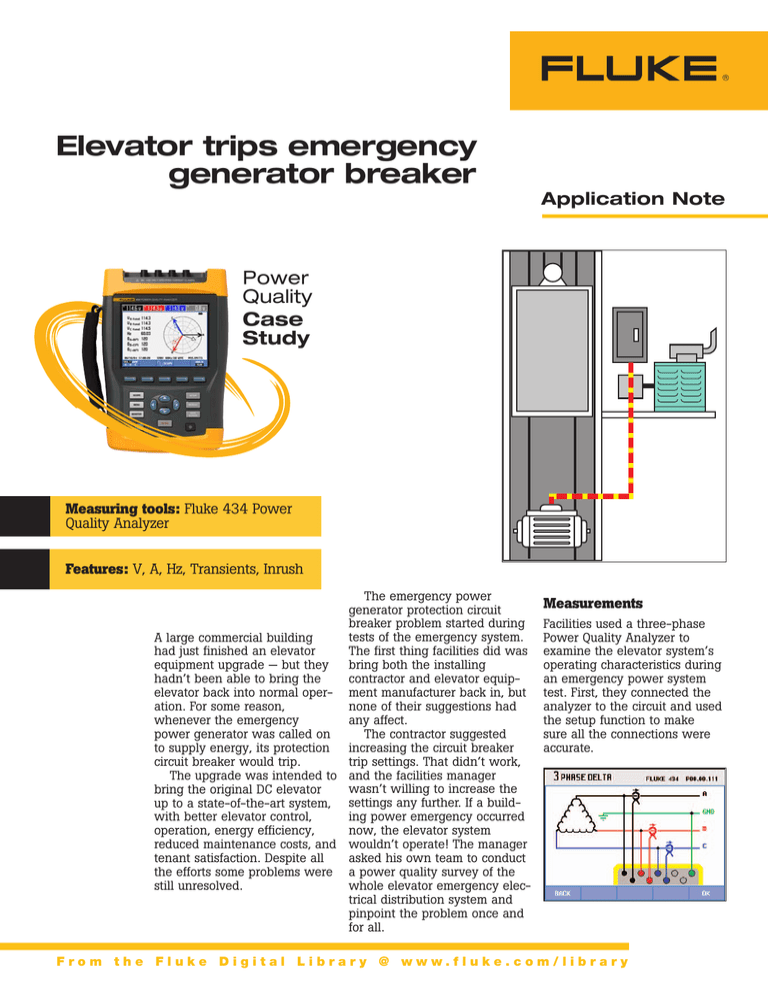
Elevator trips emergency
generator breaker
Application Note
Power
Quality
Case
Study
Measuring tools: Fluke 434 Power
Quality Analyzer
Features: V, A, Hz, Transients, Inrush
The emergency power
generator protection circuit
breaker problem started during
tests of the emergency system.
A large commercial building
The first thing facilities did was
had just finished an elevator
bring both the installing
equipment upgrade — but they
contractor and elevator equiphadn’t been able to bring the
elevator back into normal oper- ment manufacturer back in, but
none of their suggestions had
ation. For some reason,
any affect.
whenever the emergency
The contractor suggested
power generator was called on
to supply energy, its protection increasing the circuit breaker
trip settings. That didn’t work,
circuit breaker would trip.
The upgrade was intended to and the facilities manager
wasn’t willing to increase the
bring the original DC elevator
up to a state-of-the-art system, settings any further. If a building power emergency occurred
with better elevator control,
now, the elevator system
operation, energy efficiency,
reduced maintenance costs, and wouldn’t operate! The manager
asked his own team to conduct
tenant satisfaction. Despite all
the efforts some problems were a power quality survey of the
whole elevator emergency elecstill unresolved.
trical distribution system and
pinpoint the problem once and
for all.
Measurements
Facilities used a three-phase
Power Quality Analyzer to
examine the elevator system’s
operating characteristics during
an emergency power system
test. First, they connected the
analyzer to the circuit and used
the setup function to make
sure all the connections were
accurate.
From the Fluke Digital Library @ www.fluke.com/library
Then, they selected the
Volts/Amps/Hertz feature from
the menu. The power quality
analyzer immediately began
recording voltage and current
on all three phases. Then, one
technician conducted a generator test. As predicted, the
breaker tripped.
Looking at the trended
Volts/ Amps/Hertz data, the
technicians could see where
the breaker tripped, but they
didn’t see any event data that
would have caused it. This
problem was too fast for regular
readings.
All three phase voltages go to zero until the
circuit breaker is reset.
The team switched to the
analyzer’s Transients function,
so they could see transients as
fast as 5 microseconds, started
recording and conducted the
generator test. When the
breaker tripped this time, a
transient was clearly evident.
Sample screen.
In modern power systems,
transients are present all the
time, some small and some
large. Switching of inductive
loads, lightning strikes and
transmission system switching
can all generate huge voltage
spikes. These transient voltage
spikes last as long as 100
microseconds and can be
extremely dangerous.
More commonly, when an
inductive load such as a motor
or a transformer is switched on
or off, it generates a voltage
spike sometimes called a “kickback spike.” Given the layout of
this particular system, facilities
suspected a startup-inrush
current of some kind was causing the breaker trip.
They selected the Inrush
Currents function on the
analyzer and reviewed the
current levels for all the loads
managed by the emergency
power system. The technicians
did see an inrush event. The
inrush magnitude was within
the equipment specifications ...
but why was the inrush event
occurring when the system was
already operational?
For some reason, the elevator
system wasn’t sensing the
power fault condition. So, every
time emergency power was
reapplied, the elevator system
started to perform a normal
start-up — and that much
inrush and start-up current on
top of normal operations
exceeded the rating of the
power emergency protection
circuit breaker.
Solution:
A simple adjustment to the
elevator power fault sensing
circuit allowed the new system
to properly perform the individual elevator car power failure
procedure. In the process, facilities verified the protection
circuit breaker settings and
adjusted them back to the
proper set points.
Given our tendency to get
jobs done as fast as possible,
some testing procedures can
easily get overlooked. Even if
new or upgraded equipment
appears to perform basic operations, it doesn’t elimate the
need for comprehensive acceptance testing. If the original
installers had performed the
emergency system test themselves, they would have spotted
the problem sooner and had a
much happier customer.
Fluke. Keeping your world
up and running.
Fluke Corporation
PO Box 9090, Everett, WA USA 98206
Fluke Europe B.V.
PO Box 1186, 5602 BD
Eindhoven, The Netherlands
For more information call:
In the U.S.A. (800) 443-5853 or
Fax (425) 446-5116
In Europe/M-East/Africa (31 40) 2 675 200 or
Fax (31 40) 2 675 222
In Canada (800)-36-FLUKE or
Fax (905) 890-6866
From other countries +1 (425) 446-5500 or
Fax +1 (425) 446-5116
Web access: http://www.fluke.com/
2 Fluke Corporation
Power Quality Case Study: Elevator trips emergency generator breaker
©2005 Fluke Corporation. All rights reserved.
Printed in U.S.A. 1/2005 2398469 A-US-N Rev A



